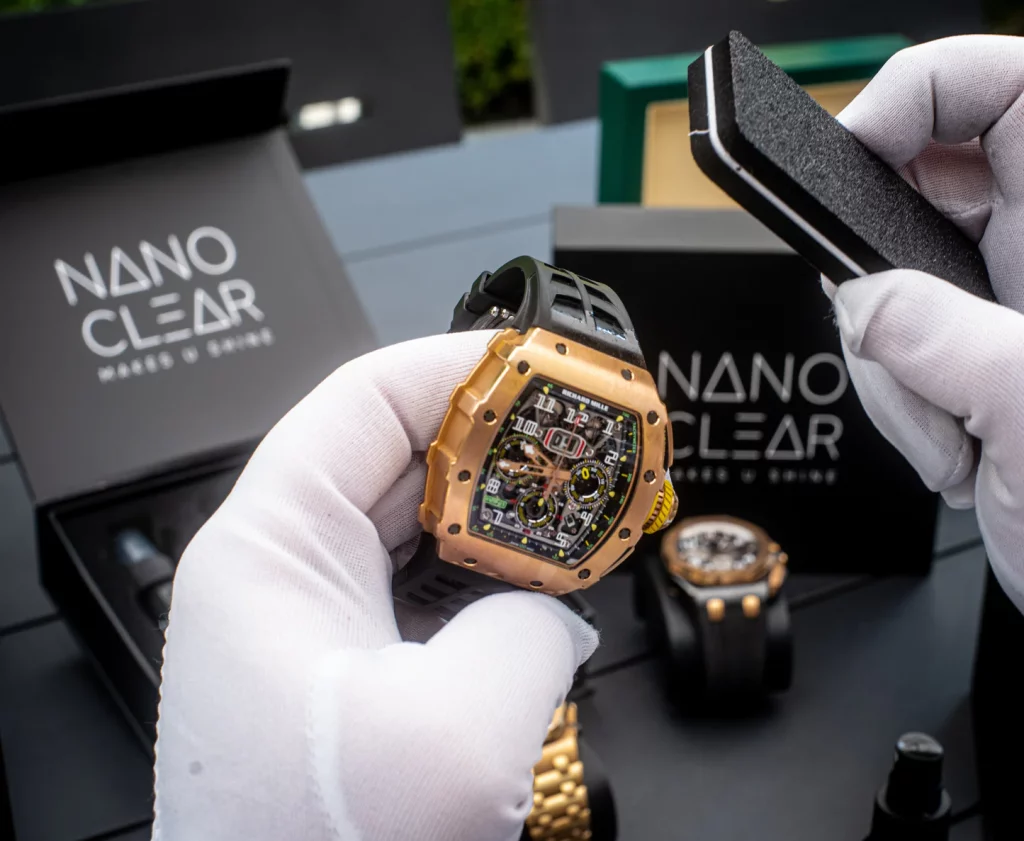Graphene Revolution or Marketing Gimmick? Understanding the $20 Anti-Scratch Miracle
Walk into a watch forum in 2025 and it won’t take long before someone brings up the $20 miracle spray promising to end the need for traditional servicing. Marketed as “nano-graphene coatings,” these consumer-grade products boast anti-scratch capabilities rated at Mohs hardness 9—just one level below diamond. That claim alone is enough to turn heads among collectors terrified of sapphire swirl marks, case scuffs, and clasp wear.
The allure is obvious. For the price of a coffee date in Zurich, you can supposedly apply a coating that rivals lab-grown ceramic, fusing to your case and crystal invisibly while offering near-permanent resistance to environmental damage. DIY influencers demonstrate these sprays fending off sandpaper, steel wool, and even knife scratches. TikTok is flooded with time-lapse clips of $50,000 watches emerging unscathed from amateur abrasion gauntlets. And the question inevitably follows: could this be the death knell for the high-cost, biannual luxury watch service?
But beneath the marketing gloss lies a more complex story—one where chemistry, horology, and liability intersect. The idea of protecting your watch sounds innocuous, but in reality, applying the wrong compound in the wrong place could destroy the very movement you’re trying to preserve. And the industry is starting to take notice.
What Is Nano-Coating and Why Does Graphene Matter?
Nano-coatings are ultra-thin films—typically measured in nanometers—that bond with surfaces to create new material properties. Most sprays marketed to watch owners contain a solution of graphene oxide dispersed in a volatile carrier fluid like ethanol or acetone. Upon application, the solvent evaporates, leaving a microscopic layer of bonded carbon atoms in a hexagonal lattice. This structure is what gives graphene its almost mythical strength, thermal conductivity, and resistance to physical wear.
Graphene coatings were initially developed for aerospace, smartphone screens, and industrial bearings. But their consumer adaptation—especially for watches—has been sudden and unregulated. Some brands claim their sprays also offer oleophobic protection, UV shielding, and water resistance. Others suggest that one coat can reduce friction on bezels and bracelet links.
The Mohs scale rating is perhaps the most seductive spec. At 9, the coating would in theory repel anything short of top-tier sapphire or diamond. This positions it above stainless steel (4–5), titanium (6), and even ceramic (8). For owners of gold watches—infamously prone to scratches—this sounds like a godsend.
But real-world testing has painted a more nuanced picture. Independent labs commissioned by European horology magazines found that while some coatings did reduce micro-abrasions on case flanks and clasp areas, none fully prevented scratches under actual wear conditions over time. More critically, the coatings are difficult to apply evenly and can alter surface finishes, turning brushed steel glossy or creating hazy patterns on polished gold.
Where the Danger Lurks: The Parts You Should Never Spray
The surface-level appeal of nano-coating collapses when applied carelessly. Spray-on solutions may seem easy to use, but their dispersal isn’t as controlled as their marketing implies. Unlike a watchmaker using airbrush-grade polymers in a clean room, most consumers are applying these products in their bathrooms or kitchens—with no regard for the dozens of microtolerances inside a mechanical watch.
If even a small amount of coating migrates through the crown tube, caseback, or pusher openings, it can reach the movement. That’s where the problems begin.
Graphene compounds, particularly those suspended in industrial solvents, can damage lubricants used in the gear train, escapement, and rotor bearings. Watch oils are formulated for specific viscosities and evaporation rates. When contaminated, they become unstable—either drying out prematurely or becoming gummy. In worst-case scenarios, coatings can fuse jewels or clog capillary-style oil reservoirs in high-beat chronographs.

Anti-reflective coatings are another major concern. Several owners reported that after applying nano-sprays to domed sapphire crystals, internal AR layers began flaking within weeks. This is because graphene can act as a dispersive surface, amplifying underlying tensions in factory coatings that were never designed to be sealed by foreign compounds.
Ceramic bezels are not immune either. While inherently hard, their finish is baked at high temperatures and can interact unpredictably with spray-on coatings, resulting in dulling or, in some cases, a permanent oily sheen.
Bracelet clasps—often a collector’s first test area—are relatively safe, but even here, excessive layering can cause mechanical friction and latch failure if it builds up inside the micro-adjustment channels.
The Industry Responds: Patek Philippe’s Invisible Counteroffensive
Watch brands, initially silent, are now quietly mobilizing against the consumer coating craze. In March 2025, Patek Philippe stunned insiders by announcing a new proprietary “Anti-Replica Molecular Sealant” that’s invisible to the human eye but traceable under polarized UV. Ostensibly developed as a response to counterfeiting, this coating also acts as a forensic marker against unauthorized surface modification—including nano-sprays.
Patek’s move was seen as a shot across the bow. The brand’s press statement was diplomatically worded, but insiders confirmed it marked the first step toward enforcing stricter servicing policies. Any model showing signs of aftermarket coating—especially on the case or crystal—may be flagged as “externally modified,” potentially affecting both warranty and resale documentation.
Rolex, meanwhile, has not issued a public comment but has reportedly added solvent detection protocols to its Geneva service center intake process. Audemars Piguet is said to be exploring a silicon-based in-house alternative to offer at point-of-sale in boutiques—a “factory-approved” coating to preempt aftermarket tampering.
Independent brands like F.P. Journe and MB&F have begun requesting photographs of the watch case during warranty registration to establish a surface baseline. This move could eventually allow them to track unauthorized coating usage through digital analysis of light reflection patterns.
Should You Try It? Responsible Use Cases and the Future of Watch Surface Science
Despite the risks, not all nano-coating applications are reckless. For tool watches used in rugged environments—like diving, mountaineering, or construction—surface protection on case flanks and clasps may offer practical benefits. The key is ensuring application only on non-mechanical, sealed exteriors.
Enthusiasts experimenting with titanium watches—especially blasted Grade 2 titanium—have reported some success using low-viscosity graphene sprays to reduce skin oil absorption and maintain a uniform matte finish. For brushed steel bracelets prone to desk-diving wear marks, a single microfilm layer may delay the inevitable without affecting integrity.
The future may lie not in consumer-grade sprays, but in OEM-integrated nanotech. Already, materials engineers are exploring plasma-enhanced deposition (PED) systems that could embed graphene properties during the case finishing phase at the factory level. Such methods would preserve the performance benefits while ensuring no chemical crossover into the movement.
In the meantime, the wisest advice remains the most traditional: respect the engineering boundaries of your watch. A mechanical timepiece is not a smartphone screen or a car window. It is a symphony of microscopic tolerances, and even the strongest surface coating is no match for a misapplied ambition.
Conclusion: A New Layer of Complexity in Luxury Ownership
The rise of $20 nano-coating sprays introduces a provocative new chapter in the evolving relationship between watch owners and the machines on their wrists. As technology democratizes tools once reserved for labs and factories, the line between care and corrosion blurs. What appears as protection may, in fact, be violation.
Ultimately, the idea of sealing a luxury watch in an invisible armor may be tempting—but it also suggests a deeper anxiety: the desire to halt time, to freeze perfection, to escape entropy. But watches, by their very nature, mark decay. They are built to age with us.
And perhaps that’s what no coating, no matter how nano, can ever replace.










































